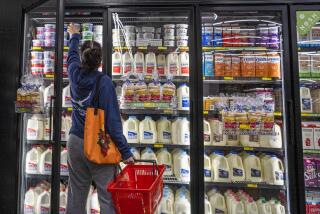Consumers Cut Use of Credit in November
- Share via
WASHINGTON — Consumer credit stalled again in November after growing during the previous two months, the first growth since spring, the government said Wednesday.
The Federal Reserve Board said installment debt was virtually unchanged at an annual rate, up just a seasonally adjusted $27 million. Indeed, debt would have fallen had it not been for consumers’ continued use of credit cards as Christmas approached.
Automobile loans, which had fallen every month this year, continued their decline in November. Auto makers reported earlier this week that sales in 1991 were the worst since 1983, when the economy was emerging from the last recession.
Consumer credit includes all consumer loans except mortgages and home-equity loans. It helps finance much of overall consumer spending, which represents two-thirds of the nation’s economic activity.
Fed Chairman Alan Greenspan has said a huge overhang of consumer debt from the 1980s was one factor hindering efforts to get out of the current economic downturn.
Some economists contend that consumers are using credit cards only for necessities they could not otherwise afford and avoiding many other discretionary purchases altogether.
Consumers had taken on more installment debt in October than first was estimated, Wednesday’s report showed. The Fed said consumer credit grew at a 2.7% annual rate, compared to the 1.3% that had been first reported.
The barely perceptible 0.1% advance in September had been the first gain since consumer credit jumped 1.9% last April.
Revolving credit, purchases charged on credit cards, increased 5.2% at an annual rate. Still, that was slower than the 8.2% advance in October and less than half of September’s 13.7% jump.
Purchases charged on credit cards expanded in November by $1.01 billion, lower than the increases of $1.59 billion registered in October and $2.62 billion in September.
Car loans, on the other hand, dropped at a 4.2% rate after declines of 0.9% in October and 7.4% in September. And dismal sales reports suggest that credit use for automobile purchases also fell in December.
Bank and credit union loans not secured by real estate slipped 0.9% in November after growing 1.4% a month earlier.
But borrowing for mobile homes gained 7.9% after a 3.2% increase in October. Those advances failed to recoup a 37.1% plunge in September.
The changes left consumers holding $733 billion in installment debt at the end of November, 0.8% less than they held a year earlier.
More to Read
Inside the business of entertainment
The Wide Shot brings you news, analysis and insights on everything from streaming wars to production — and what it all means for the future.
You may occasionally receive promotional content from the Los Angeles Times.










